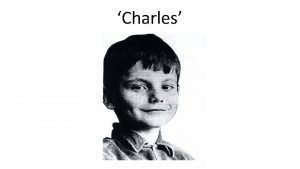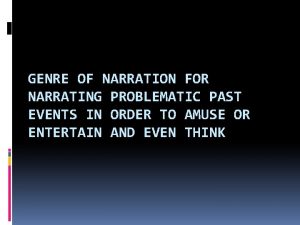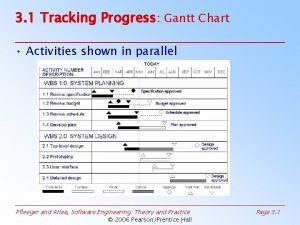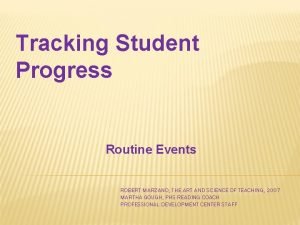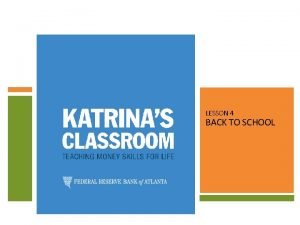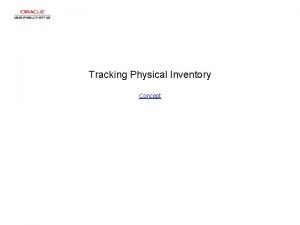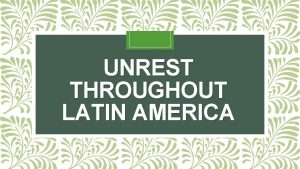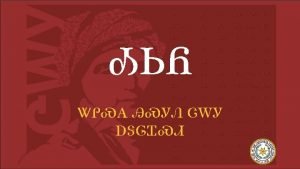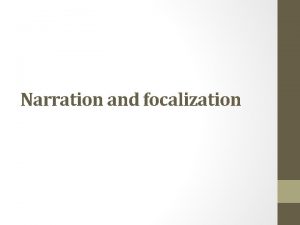Tracking and narrating progress throughout the lesson LO









- Slides: 9

Tracking and narrating progress throughout the lesson LO: To know a variety of techniques that will allow us to track and comment on student progress throughout the lesson.

Why? • ‘. . . a sense of progress will be palpable when pupils are able to articulate their understanding of the learning they are involved in and point to success criteria and formative feedback that is helping them to move forward. In other words, outstanding lessons are those in which pupils are fully assessment literate. . . ’ Perfect Assessment for Learning, Claire Gadsby

1 I don’t know how to measure pupils’ progress. I know how to measure pupils’ progress. What is it: RYG scale How does it work: Students write their name on a post-it and place it somewhere on the scale. If they place it in green, they have to write a justification on the post-it i. e. , I am green because I have learnt quite a few different techniques.

2 o d t a Wh ? w no k y d a e r l a I I t a h W ? t rn a e l ve a h What is it: Brain plenary How does it work: Students can articulate their learning by filling in their ‘brain’ at different points in the lesson. This can be collected in, or students can be called upon to read what they have included.

3 What do you already ü To understand the mark scheme for Question B. know? What do you want to know? l What have you earned? What is it: KWL grid How does it work: Students are provided with a stimulus at the start of the lesson (either an example of a perfect piece of work, or the thing that they will be learning about). They write down what they already know about this in K, and set themselves questions in W. The aim is that they answer their own questions in the lesson, posting the answers in L.

üTo be able to add the R (Reader Response) section to our PETE paragraphs. The most difficult thing was. . . A question I have about today’s lesson is. . . Reflection 4 The progress I have made today is. . . I am now able to. . . I now understand that. . . I think I need to improve on. . . The thing I enjoyed most If I did my work about today’s lesson was. . . again I would change. . . I have learnt today. . . The term. . . was used today. It means. . . What is it: Reflection sentence stems How does it work: At key moments in the lesson, students use these to articulate and reflect on their learning. This can be done in private, or as part of ‘Last Man Standing’.

Two for True / Last Man Standing 5 • ‘Last Man Standing’ involves all pupils standing up before being invited to sit down when they have contributed something to the discussion of what has been learned. • ‘Two for True’ involves the teacher, or better still a pupil, reading out a statement about the learning. The pupils raise one hand for false, and two for true.

To understand the gang system that makes up Verona in Romeo and Juliet. I can outline reasons for why gang identity is important to people I can apply the terms bipolar, masculinity, reputation and bravado to this. 6 I can apply my understanding of gang warfare to the play and film. 0 ---------------------------------------10 What is it: Learning continuum How does it work: The learning objective is split up into constituent parts that make it up. After each part, either the students can rate their progress, or the teacher can simply return to the objective and discuss.

Pupils set their own questions • Provide the pupils with a stimulus at the beginning of the lesson. This can be either: – An example of a perfect piece of work, – An example of a question that the students will be able to answer at the end of the lesson, – An example of a text that the students will learn to analyse • Students can then either: – Pick out elements of the writing that they want to understand / be able to use for themselves, – Plan out how they might be able to answer the question/ what they need to do to get there 7
 Who is narrating the short story charles?
Who is narrating the short story charles? The fish told sahala seriously.
The fish told sahala seriously. Physical progress and financial progress
Physical progress and financial progress Gantt chart progress tracking
Gantt chart progress tracking Tracking student progress charts
Tracking student progress charts Lesson 4 tracking your expenses ramsey answer key
Lesson 4 tracking your expenses ramsey answer key Progress and performance measurement and evaluation
Progress and performance measurement and evaluation Progress and performance measurement and evaluation
Progress and performance measurement and evaluation Hát kết hợp bộ gõ cơ thể
Hát kết hợp bộ gõ cơ thể Frameset trong html5
Frameset trong html5
